人教版九年级全册Unit13 We're trying to save the earthSectionA Grammar Focus-4c课件(共19张PPT)
文档属性
| 名称 | 人教版九年级全册Unit13 We're trying to save the earthSectionA Grammar Focus-4c课件(共19张PPT) | 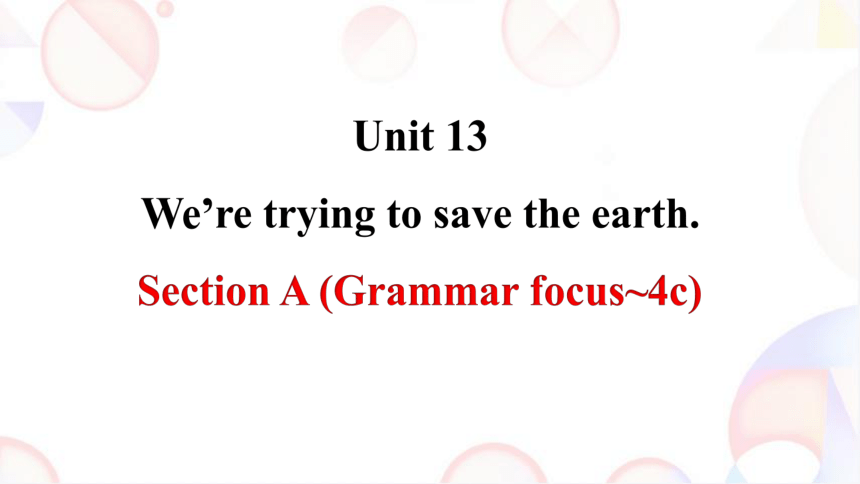 | |
| 格式 | pptx | ||
| 文件大小 | 1.0MB | ||
| 资源类型 | 教案 | ||
| 版本资源 | 人教新目标(Go for it)版 | ||
| 科目 | 英语 | ||
| 更新时间 | 2024-09-20 19:09:30 | ||
图片预览

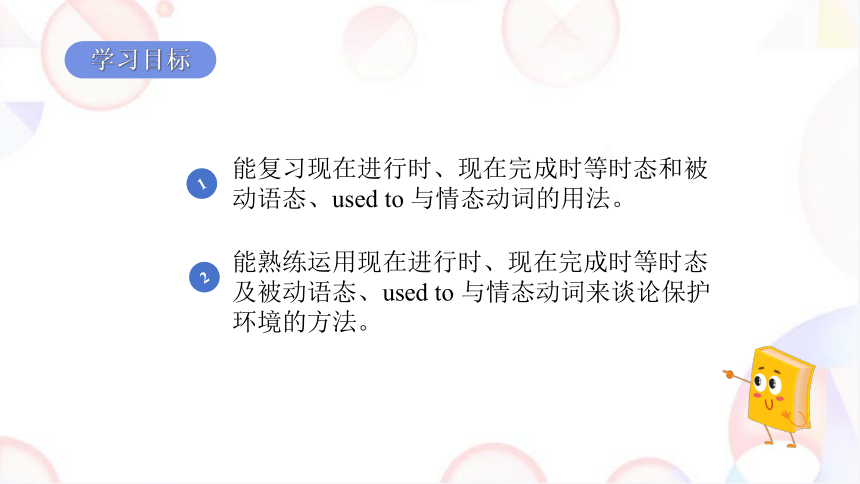
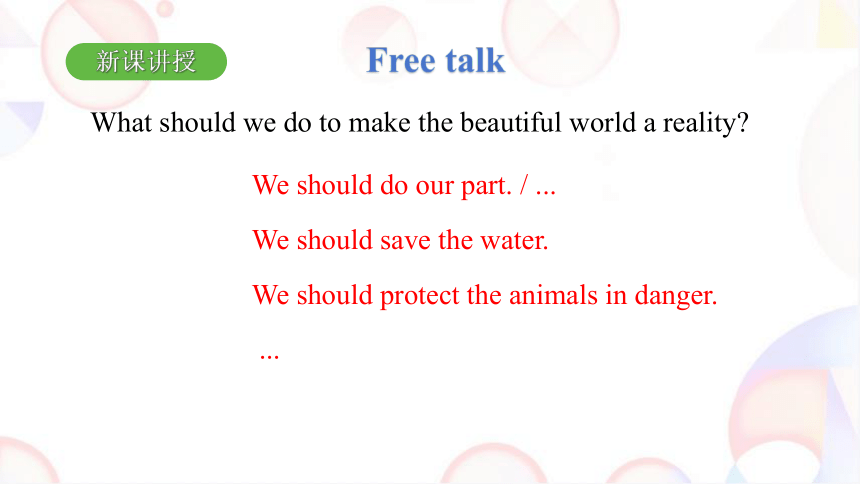
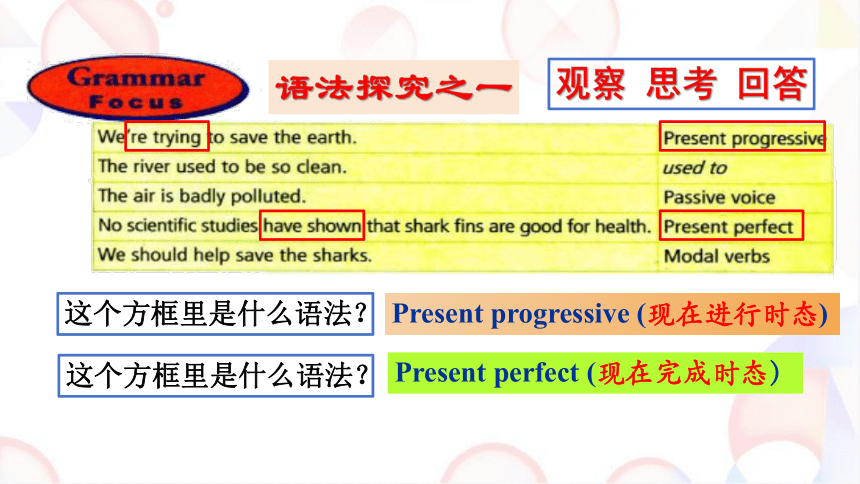
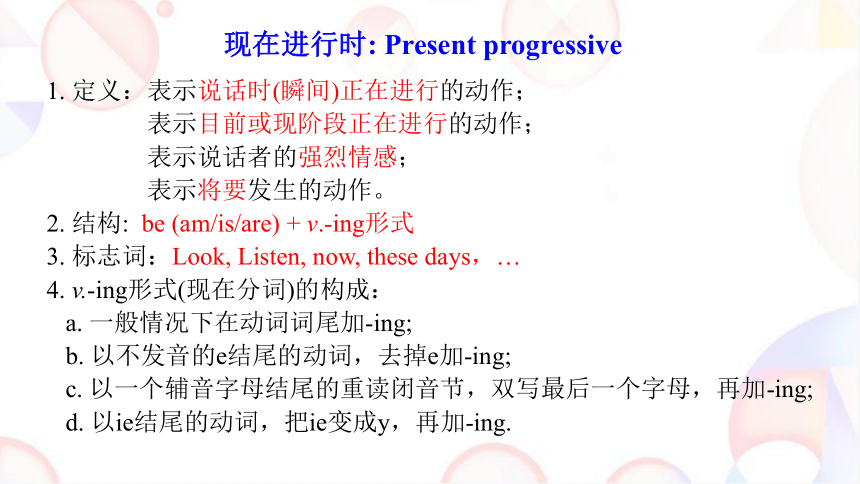
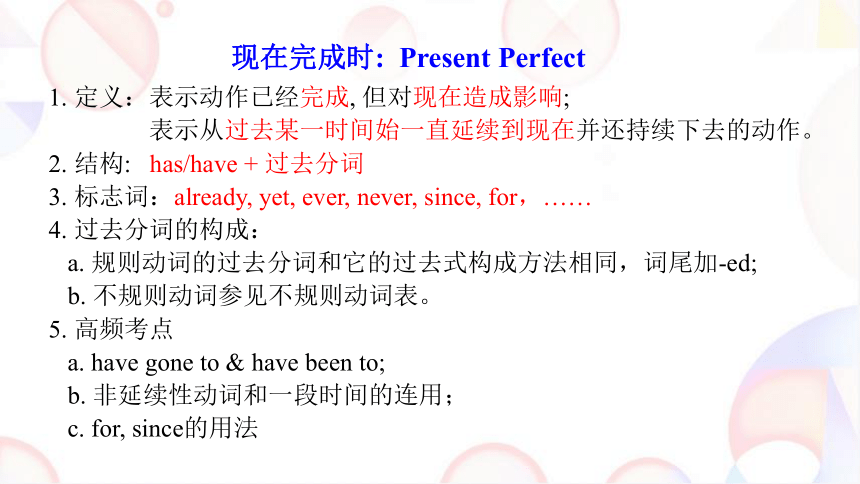
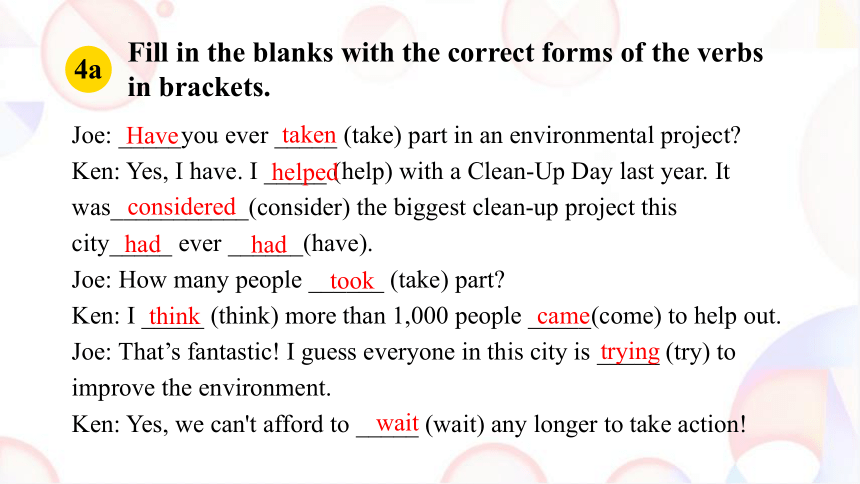
文档简介
(共19张PPT)
Unit 13
We’re trying to save the earth.
Section A (Grammar focus~4c)
学习目标
1
2
能熟练运用现在进行时、现在完成时等时态及被动语态、used to 与情态动词来谈论保护环境的方法。
能复习现在进行时、现在完成时等时态和被动语态、used to 与情态动词的用法。
Free talk
What should we do to make the beautiful world a reality
We should do our part. / ...
We should save the water.
We should protect the animals in danger.
...
新课讲授
语法探究之一
观察 思考 回答
Present perfect (现在完成时态)
这个方框里是什么语法?
Present progressive (现在进行时态)
这个方框里是什么语法?
现在进行时: Present progressive
1. 定义:表示说话时(瞬间)正在进行的动作;
表示目前或现阶段正在进行的动作;
表示说话者的强烈情感;
表示将要发生的动作。
2. 结构: be (am/is/are) + v.-ing形式
3. 标志词:Look, Listen, now, these days,…
4. v.-ing形式(现在分词)的构成:
a. 一般情况下在动词词尾加-ing;
b. 以不发音的e结尾的动词,去掉e加-ing;
c. 以一个辅音字母结尾的重读闭音节,双写最后一个字母,再加-ing;
d. 以ie结尾的动词,把ie变成y,再加-ing.
1. 定义:表示动作已经完成, 但对现在造成影响;
表示从过去某一时间始一直延续到现在并还持续下去的动作。
2. 结构: has/have + 过去分词
3. 标志词:already, yet, ever, never, since, for,……
4. 过去分词的构成:
a. 规则动词的过去分词和它的过去式构成方法相同,词尾加-ed;
b. 不规则动词参见不规则动词表。
5. 高频考点
a. have gone to & have been to;
b. 非延续性动词和一段时间的连用;
c. for, since的用法
现在完成时: Present Perfect
Fill in the blanks with the correct forms of the verbs in brackets.
4a
Joe: _____you ever _____ (take) part in an environmental project
Ken: Yes, I have. I _____ (help) with a Clean-Up Day last year. It was___________(consider) the biggest clean-up project this
city_____ ever ______(have).
Joe: How many people ______ (take) part
Ken: I _____ (think) more than 1,000 people _____(come) to help out.
Joe: That’s fantastic! I guess everyone in this city is _____ (try) to improve the environment.
Ken: Yes, we can't afford to _____ (wait) any longer to take action!
Have
helped
considered
had
had
taken
took
think
came
trying
wait
语法探究之二
观察 思考 回答
used to (do sth.) 表示过去常常做某事, 而现在往往不做了,
后接 动词原形。
方框里短语是什么意思?
辨析:used to do sth.;
be/get used to doing sth.
be used to do sth.
1. used to do sth. 意为“过去常常做某事(而现在不做了)”。后接动词原形。
I used to eat pork.
2. be/get used to doing sth. 意为“习惯于(做)某事”。后接动词使用-ing形式。
I’m used to riding to school now.
3. be used to do sth. 意为“被用来做某事”。这是被动结构,后接动词原形。
Wood can be used to make paper.
语法探究之三
观察 思考 回答
Passive voice (被动语态)
方框里是什么语法?
被动语态:Passive voice
1. 语态定义:当谓语表示一个动作时,主语和它可以有两种不同 关系;主
动关系或被动关系。 在表示主动关系时(即主语为动作的
执行者时),谓语的形式称为主动语态(the Active Voice);
在表示被动 关系时(即主语为动作的承受者时),谓语要用
另一种形 式,称为被动语态(the Passive Voice)。
2. 被动语态用法:
a. 讲话者不知道动作的执行者,不必或不便说出动作的执行者(这时可
省掉by引导的短语);
b. 借助被动的动作突出动作的承受者
3. 被动语态基本结构:be + 过去分词
被动语态:Passive voice
4. 高频考点
a. 常考五种被动语态的结构(以动词do为例):
① 一般现在时: am/is/are+ done
② 一般过去时: was/were+done
③ 一般将来时: will be/is(/am/are) going to be+ done
④ 现在完成时:have/has been+done
⑤ 含情态动词: can/may/must...+be+done
b. 被动语态感使动词后的动词不定式做宾语补足语的用法
hear, see, make, let, ...
语法探究之四
观察 思考 回答
Modal verb (情态动词)
方框里是什么词类?
情态动词 Modal verbs
1. 定义:情态动词本身有一定的词义, 表示说话人的情绪、态度或语气, 无
人称和数的变化,但不能单独作谓语, 后接省略to的动词不定式
(即动词原形)构成谓语。否定式是在情态动词后面加not。
2. 用法:
a. 表能力: can, could, be able to
b. 表推测: might, could, may, can, must, can’t (可能性依次递增)
c. 表建议: shall, should, had better
d. 表委婉: may, might, can, could, will, would
e. 表义务: must, need, have to
Fill in the blanks with the appropriate modal verbs from the box.
4b
People _____ think that big things _____ be done to save the earth. Many forget that saving the earth begins with small things. For example, you _____ save electricity by turning off the lights when you leave a room. You _____ also use reusable bags instead of plastic bags.
may
must
could
could
can would could have to should must may/might
可重复使用的
Fill in the blanks with the appropriate modal verbs from the box.
4b
can would could have to should must may/might
I think it’s a great idea that you now _______ pay for plastic bags in some stores. And instead of driving to school or work, you _____ ride your bike or walk. If it’s far, you ______ take the bus. All these small things ______ add up and become good things that ____ improve the environment. Let’s take action now!
have to
can
could
can
can
付费
采取行动
Make a list of things that people can do to help the
environment and discuss your list with your partner.
A:I think that everyone should use public transportation.
B:I disagree. It’s difficult for parents with young
children to use public transportation...
use public transportation_____
_________________________
bring a bag to go shopping
4c
1. Doing exercises in the open air is good your health.
A. for B. to C. with D. at
2. Tom Jack is poor in Chinese. So we often help them.
A. Not only; but also B. Either; or
C. Neither; nor D. Both; and
单项填空。
A
A
课堂检测
3. He the lights and the room was in completely darkness.
A. turned on B. turned up C. turned down D. turned off
4. teachers in our school is 100, and them are women teachers.
A. The number of; a number of B. The number of; the number of
C. A number of; a number of D. A number of; the number of
5. —Some children can't afford necessary stationery.
—Let's donate our pocket money to them.
A. buy B. buying C. to buy D. be bought
D
A
C
Unit 13
We’re trying to save the earth.
Section A (Grammar focus~4c)
学习目标
1
2
能熟练运用现在进行时、现在完成时等时态及被动语态、used to 与情态动词来谈论保护环境的方法。
能复习现在进行时、现在完成时等时态和被动语态、used to 与情态动词的用法。
Free talk
What should we do to make the beautiful world a reality
We should do our part. / ...
We should save the water.
We should protect the animals in danger.
...
新课讲授
语法探究之一
观察 思考 回答
Present perfect (现在完成时态)
这个方框里是什么语法?
Present progressive (现在进行时态)
这个方框里是什么语法?
现在进行时: Present progressive
1. 定义:表示说话时(瞬间)正在进行的动作;
表示目前或现阶段正在进行的动作;
表示说话者的强烈情感;
表示将要发生的动作。
2. 结构: be (am/is/are) + v.-ing形式
3. 标志词:Look, Listen, now, these days,…
4. v.-ing形式(现在分词)的构成:
a. 一般情况下在动词词尾加-ing;
b. 以不发音的e结尾的动词,去掉e加-ing;
c. 以一个辅音字母结尾的重读闭音节,双写最后一个字母,再加-ing;
d. 以ie结尾的动词,把ie变成y,再加-ing.
1. 定义:表示动作已经完成, 但对现在造成影响;
表示从过去某一时间始一直延续到现在并还持续下去的动作。
2. 结构: has/have + 过去分词
3. 标志词:already, yet, ever, never, since, for,……
4. 过去分词的构成:
a. 规则动词的过去分词和它的过去式构成方法相同,词尾加-ed;
b. 不规则动词参见不规则动词表。
5. 高频考点
a. have gone to & have been to;
b. 非延续性动词和一段时间的连用;
c. for, since的用法
现在完成时: Present Perfect
Fill in the blanks with the correct forms of the verbs in brackets.
4a
Joe: _____you ever _____ (take) part in an environmental project
Ken: Yes, I have. I _____ (help) with a Clean-Up Day last year. It was___________(consider) the biggest clean-up project this
city_____ ever ______(have).
Joe: How many people ______ (take) part
Ken: I _____ (think) more than 1,000 people _____(come) to help out.
Joe: That’s fantastic! I guess everyone in this city is _____ (try) to improve the environment.
Ken: Yes, we can't afford to _____ (wait) any longer to take action!
Have
helped
considered
had
had
taken
took
think
came
trying
wait
语法探究之二
观察 思考 回答
used to (do sth.) 表示过去常常做某事, 而现在往往不做了,
后接 动词原形。
方框里短语是什么意思?
辨析:used to do sth.;
be/get used to doing sth.
be used to do sth.
1. used to do sth. 意为“过去常常做某事(而现在不做了)”。后接动词原形。
I used to eat pork.
2. be/get used to doing sth. 意为“习惯于(做)某事”。后接动词使用-ing形式。
I’m used to riding to school now.
3. be used to do sth. 意为“被用来做某事”。这是被动结构,后接动词原形。
Wood can be used to make paper.
语法探究之三
观察 思考 回答
Passive voice (被动语态)
方框里是什么语法?
被动语态:Passive voice
1. 语态定义:当谓语表示一个动作时,主语和它可以有两种不同 关系;主
动关系或被动关系。 在表示主动关系时(即主语为动作的
执行者时),谓语的形式称为主动语态(the Active Voice);
在表示被动 关系时(即主语为动作的承受者时),谓语要用
另一种形 式,称为被动语态(the Passive Voice)。
2. 被动语态用法:
a. 讲话者不知道动作的执行者,不必或不便说出动作的执行者(这时可
省掉by引导的短语);
b. 借助被动的动作突出动作的承受者
3. 被动语态基本结构:be + 过去分词
被动语态:Passive voice
4. 高频考点
a. 常考五种被动语态的结构(以动词do为例):
① 一般现在时: am/is/are+ done
② 一般过去时: was/were+done
③ 一般将来时: will be/is(/am/are) going to be+ done
④ 现在完成时:have/has been+done
⑤ 含情态动词: can/may/must...+be+done
b. 被动语态感使动词后的动词不定式做宾语补足语的用法
hear, see, make, let, ...
语法探究之四
观察 思考 回答
Modal verb (情态动词)
方框里是什么词类?
情态动词 Modal verbs
1. 定义:情态动词本身有一定的词义, 表示说话人的情绪、态度或语气, 无
人称和数的变化,但不能单独作谓语, 后接省略to的动词不定式
(即动词原形)构成谓语。否定式是在情态动词后面加not。
2. 用法:
a. 表能力: can, could, be able to
b. 表推测: might, could, may, can, must, can’t (可能性依次递增)
c. 表建议: shall, should, had better
d. 表委婉: may, might, can, could, will, would
e. 表义务: must, need, have to
Fill in the blanks with the appropriate modal verbs from the box.
4b
People _____ think that big things _____ be done to save the earth. Many forget that saving the earth begins with small things. For example, you _____ save electricity by turning off the lights when you leave a room. You _____ also use reusable bags instead of plastic bags.
may
must
could
could
can would could have to should must may/might
可重复使用的
Fill in the blanks with the appropriate modal verbs from the box.
4b
can would could have to should must may/might
I think it’s a great idea that you now _______ pay for plastic bags in some stores. And instead of driving to school or work, you _____ ride your bike or walk. If it’s far, you ______ take the bus. All these small things ______ add up and become good things that ____ improve the environment. Let’s take action now!
have to
can
could
can
can
付费
采取行动
Make a list of things that people can do to help the
environment and discuss your list with your partner.
A:I think that everyone should use public transportation.
B:I disagree. It’s difficult for parents with young
children to use public transportation...
use public transportation_____
_________________________
bring a bag to go shopping
4c
1. Doing exercises in the open air is good your health.
A. for B. to C. with D. at
2. Tom Jack is poor in Chinese. So we often help them.
A. Not only; but also B. Either; or
C. Neither; nor D. Both; and
单项填空。
A
A
课堂检测
3. He the lights and the room was in completely darkness.
A. turned on B. turned up C. turned down D. turned off
4. teachers in our school is 100, and them are women teachers.
A. The number of; a number of B. The number of; the number of
C. A number of; a number of D. A number of; the number of
5. —Some children can't afford necessary stationery.
—Let's donate our pocket money to them.
A. buy B. buying C. to buy D. be bought
D
A
C
同课章节目录
- Unit 1 How can we become good learners.
- Section A
- Section B
- Unit 2 I think that mooncakes are delicious!
- Section A
- Section B
- Unit 3 Could you please tell me where the restroom
- Section A
- Section B
- Unit 4 I used to be afraid of the dark.
- Section A
- Section B
- Unit 5 What are the shirts made of?
- Section A
- Section B
- Review of Units 1-5
- Unit 6 When was it invented?
- Section A
- Section B
- Unit 7 Teenagers should be allowed to choose their
- Section A
- Section B
- Unit 8 It must belong to Carla.
- Section A
- Section B
- Unit 9 I like music that I can dance to.
- Section A
- Section B
- Unit 10 You're supposed to shake hands.
- Section A
- Section B
- Review of Units 6-10
- Unit 11 Sad movies make me cry.
- Section A
- Section B
- Unit 12 Life is full of the unexpected
- Section A
- Section B
- Unit 13 We're trying to save the earth!
- Section A
- Section B
- Unit 14 I remember meeting all of you in Grade 7.
- Section A
- Section B
- Review of Units 11-14
